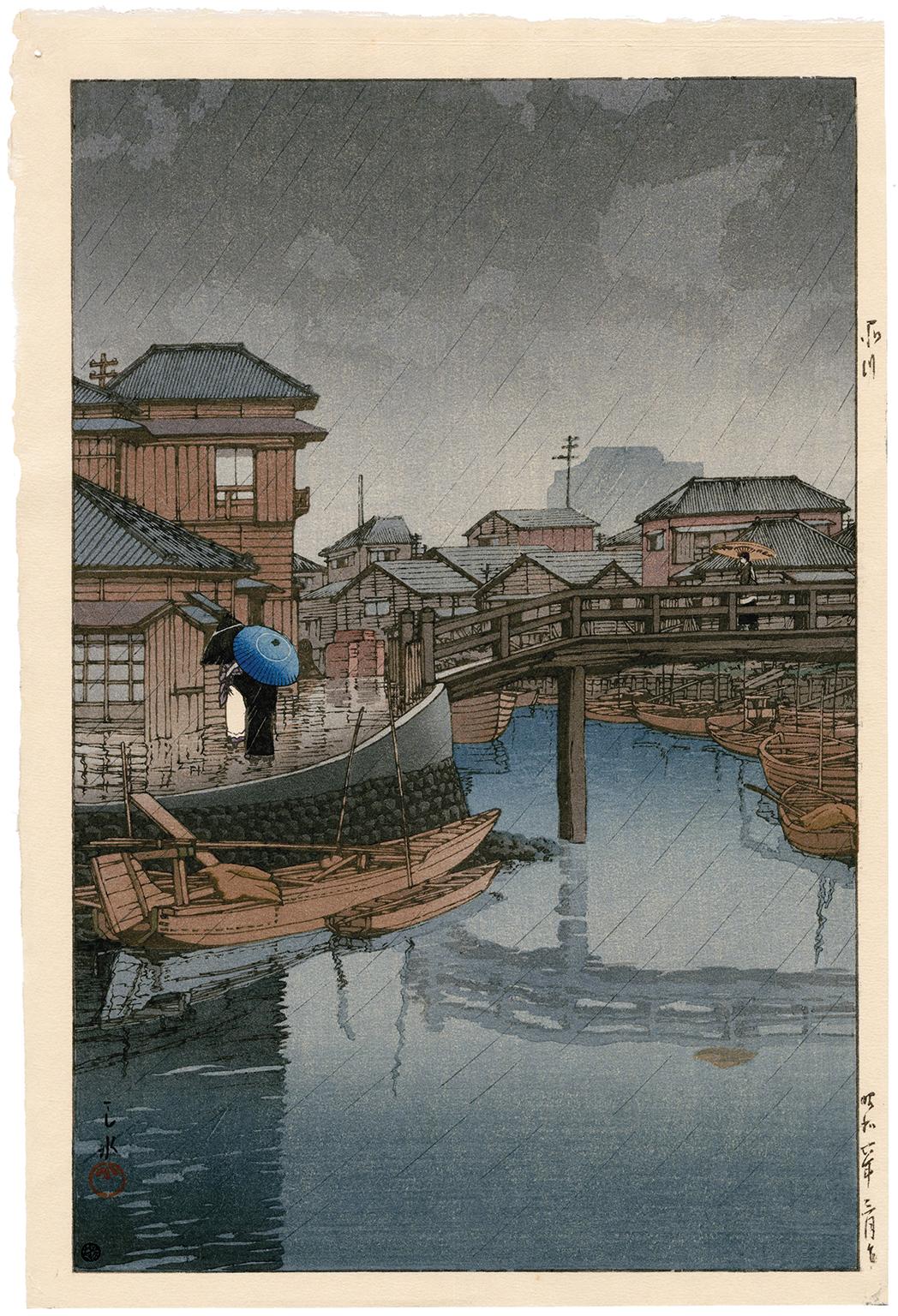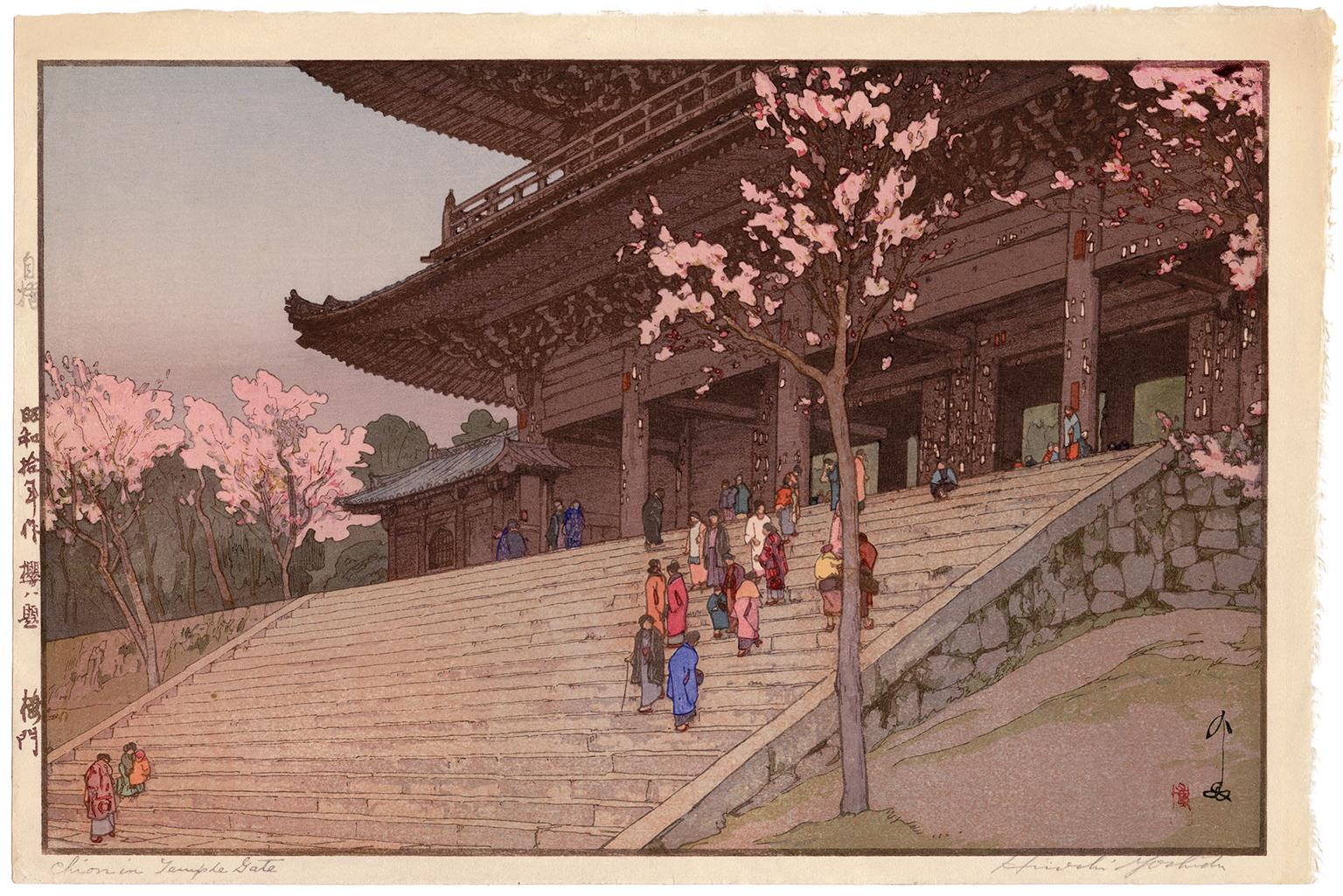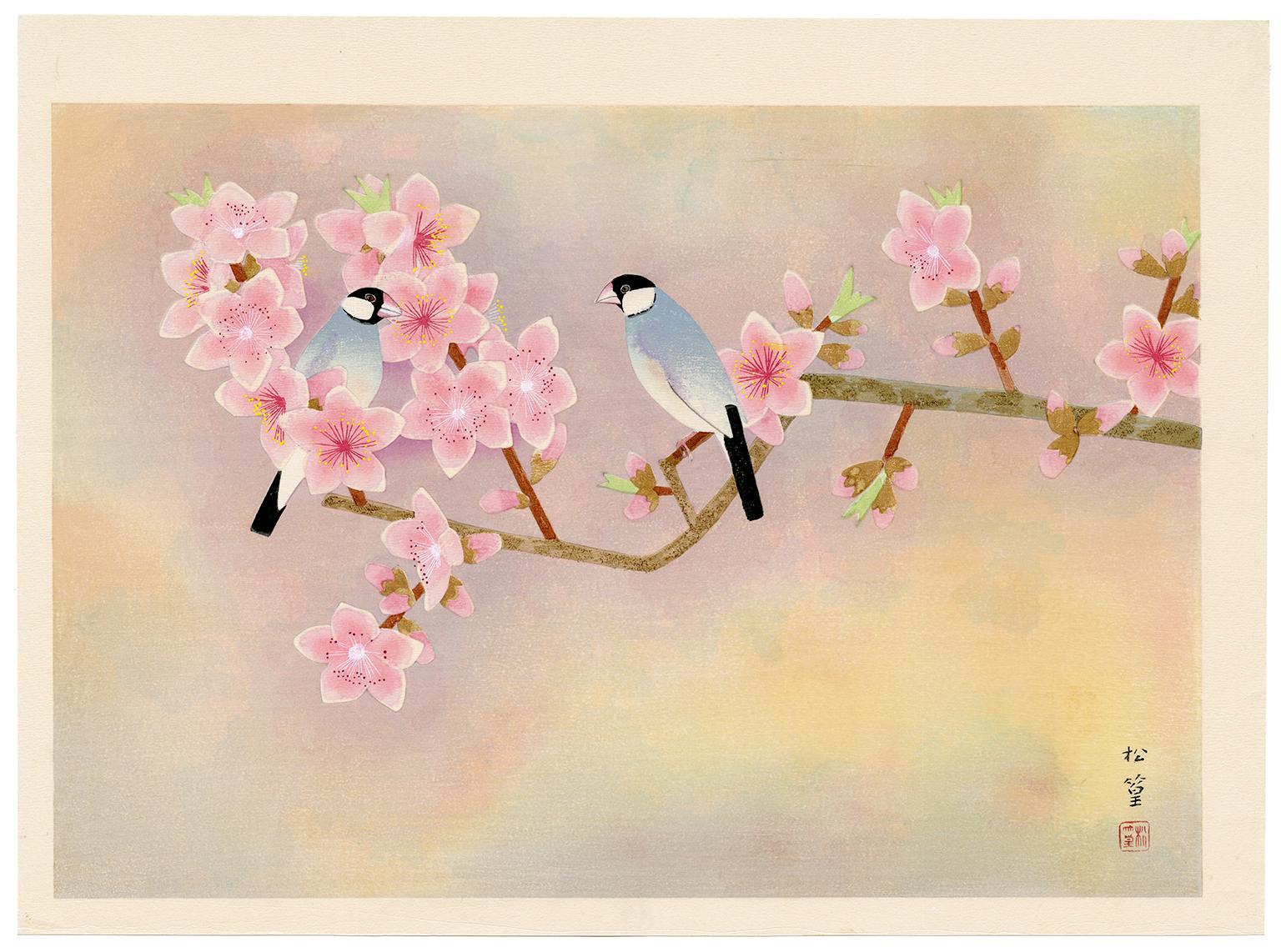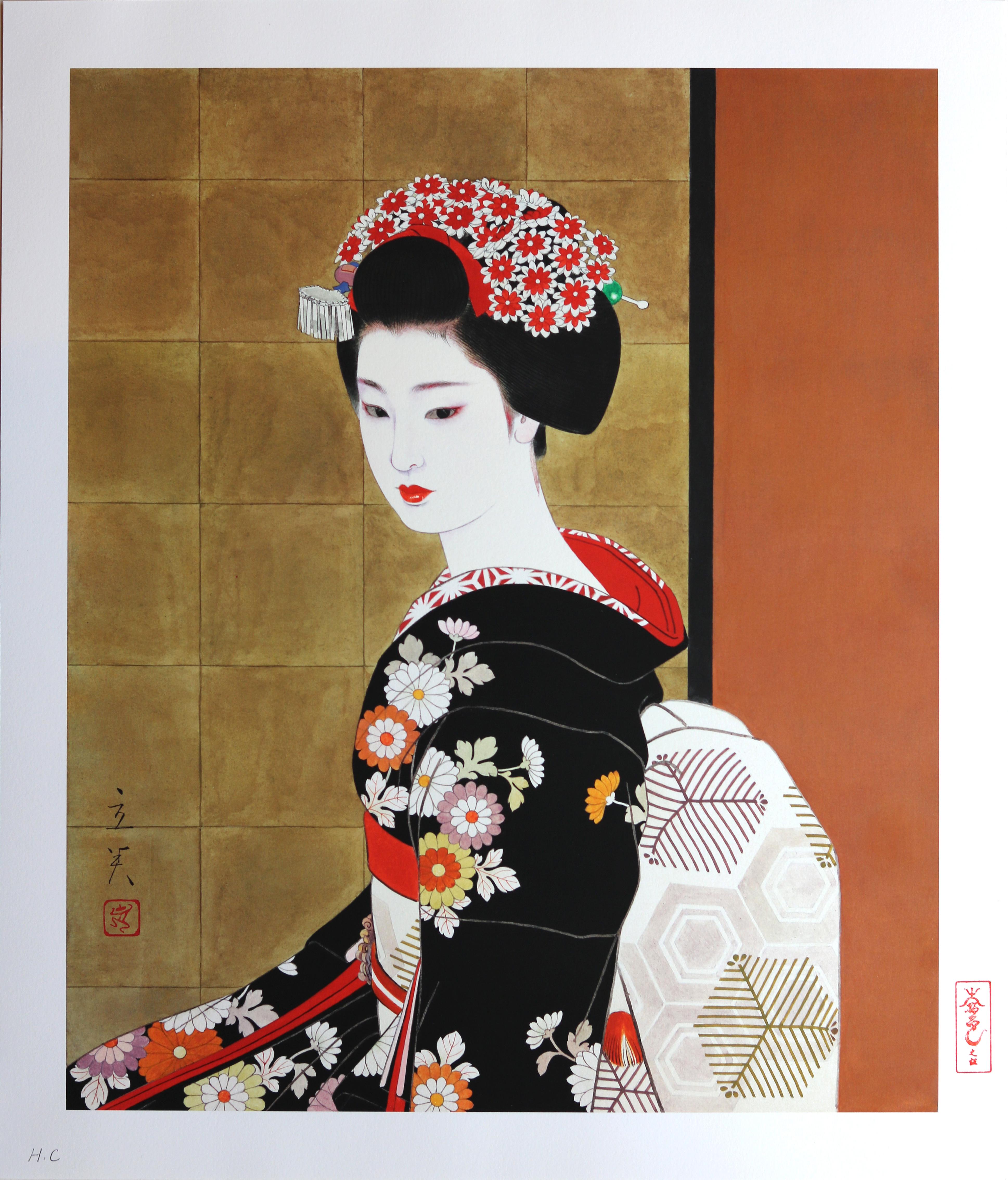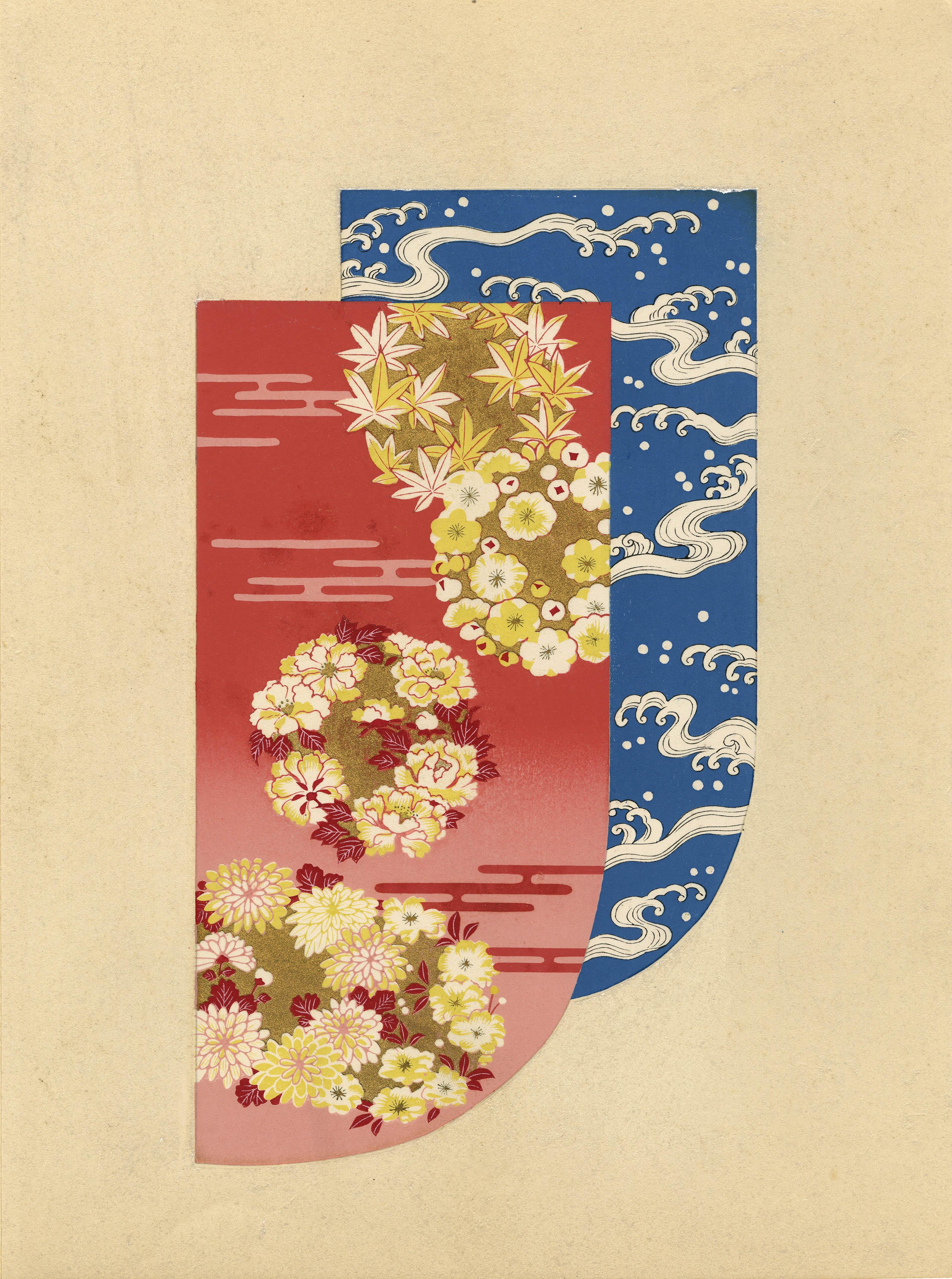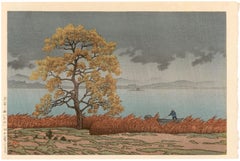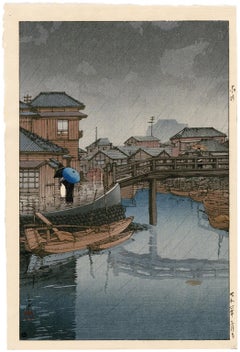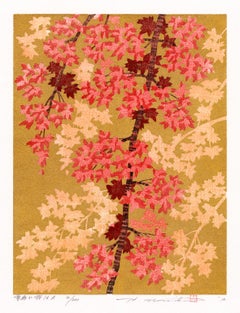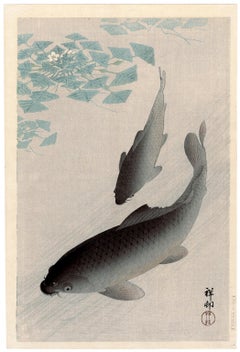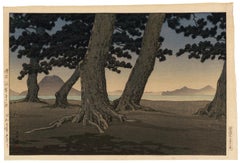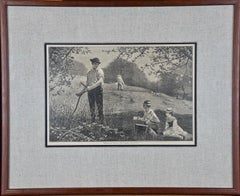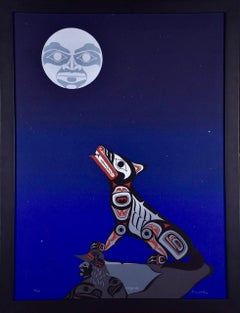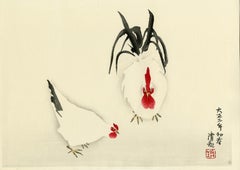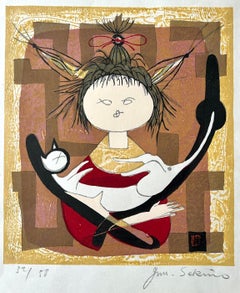Showa Prints and Multiples
to
2
20
2
1
Overall Width
to
Overall Height
to
21,317
18,865
10,814
6,023
5,583
2,678
1,556
1,423
1,250
841
816
426
344
194
3
2
2
1
1
2
18
3
2
6
7
1
2
14
8
11
6
5
5
4
4
2
2
2
2
2
2
2
2
2
2
2
1
1
1
19
2
2
2
1
23
Style: Showa
'Lakeside Shower, Matsue' — Showa-era Woodblock Print
By Kawase Hasui
Located in Myrtle Beach, SC
Kawase Hasui, 'Chihan no Ame, Matsue' (Lakeside Shower, Matsue), color woodblock print, 1932. A fine, atmospheric impression, with fresh colors; the full sheet, from a postwar editio...
Category
1930s Showa Prints and Multiples
Materials
Woodcut
'Sparrows and Bamboo in Snow' — Showa-era 'kacho-e' Woodblock Print
Located in Myrtle Beach, SC
Gesso Yoshimoto, 'Sparrows and Bamboo in Snow', woodblock print, 1930s. Signed 'Gesso', lower left. A superb, impression with fresh colors and pronounced woodgrain, fine bokashi gr...
Category
1930s Showa Prints and Multiples
Materials
Woodcut
'Rain at Shinagawa, Ryoshimachi' — Showa-era Woodblock Print
By Kawase Hasui
Located in Myrtle Beach, SC
Kawase Hasui, 'Rain at Shinagawa, Ryoshimachi' from the series 'Selection of Views of the Tokaido', woodblock print, 1931. A very fine, atmospheric impression, with fresh colors; the...
Category
1930s Showa Prints and Multiples
Materials
Woodcut
'Weeping Cherry 16 A' — Sosaku Hanga Contemporary Japanese Printmaker
Located in Myrtle Beach, SC
Hajime Namiki, 'Weeping Cherry 16 A', color woodblock print, 2012, edition 200. Signed in pencil with the artist’s red seal. Titled, dated, and numbered ...
Category
2010s Showa Prints and Multiples
Materials
Woodcut
'Carp and Water Chestnut' — Showa lifetime impression
By Ohara Koson
Located in Myrtle Beach, SC
Ohara Koson (1877-1945), 'Carp and Water Chestnut', color woodblock print, 1926. A fine impression, with fresh colors, on cream Japan paper; the full sheet, in excellent condition.
Signed 'Koson' with the artist’s red seal 'Koson'. Published by Watanabe Shozaburo. With the Watanabe 'C' seal in the lower right margin, indicating a lifetime impression printed between 1929-1942.
Image size 13 1/2 x 7 1/4 inches (343 x 184 mm); sheet size 14 1/2 x 7 1/2 inches (368 x 191 mm). Archivally sleeved, unmatted.
Literature: 'Crows, Cranes, and Camellias: The Natural World of Ohara Koson', Newland, Amy R.: Jan Perree & Robert Schaap, Leiden: Hotei Publishing, 2001. S39.1, pl 169.
Collections: National Museum of Asian Art (Smithsonian), Smart Museum of Chicago (University of Chicago).
In Japanese art, the carp represents good luck and good fortune.
ABOUT THE ARTIST
Koson Ohara...
Category
1920s Showa Prints and Multiples
Materials
Woodcut
'The Beach at Kaiganji in Sanuki Province' — Lifetime Impression
By Kawase Hasui
Located in Myrtle Beach, SC
The Beach at Kaiganji in Sanuki Province (Sanuki Kaiganji no hama), from the series Collected Views of Japan II, Kansai Edition (Nihon fûkei shû II Kansai hen), woodblock print, 1934. A very fine, atmospheric impression, with fresh colors; the full sheet, in excellent condition. Signed 'Hasui' with the artist’s seal 'Kawase', lower left. Published by Watanabe Shozaburo with the Watanabe ‘D’ seal indicating an early impression printed between 1931 - 1941. Stamped faintly 'Made in Japan' in the bottom center margin, verso.
Horizontal ôban; image size 9 3/8 x 14 1/4 inches (238 x 362 mm); sheet size approximately 10 5/16 x 15 1/2 inches ( 262 x 394 mm).
Collections: Art Institute of Chicago; Austrian Museum of Applied Arts (Vienna); Honolulu Museum of Art; Museum of Fine Arts, Boston; National Museum in Warsaw; University of Wisconsin-Madison.
ABOUT THE ARTIST
“I do not paint subjective impressions. My work is based on reality...I can not falsify...(but) I can simplify…I make mental impressions of the light and color at the time of sketching. While coloring the sketch, I am already imagining the effects in a woodblock print.” — Kawase Hasui
Hasui Kawase...
Category
1930s Showa Prints and Multiples
Materials
Woodcut
'The Spirit of the Wine' — Japanese Legend from the Famed Chikamatsu Series
Located in Myrtle Beach, SC
Hokuto Tamamura (1893-1951), 'The Spirit of the Wine' (Shuten Dōji) - from Dai Chikamatsu Zenshu (The Complete Works of Chikamatsu)', color woodblock, 1923-26. Signed 'Hokuto'. A fin...
Category
1920s Showa Prints and Multiples
Materials
Woodcut
Japanese Kimono Fabric Design — Vintage Color Woodblock Print
Located in Myrtle Beach, SC
Anonymous, Japanese Kimono Fabric Design, color woodcut, c. 1930. A superb impression, with fresh colors, fine graduations, and metallic gold motifs, on ...
Category
Early 1900s Showa Prints and Multiples
Materials
Woodcut
Traditional Japanese Geisha (Kiba II)
Located in Burbank, CA
A beautiful Japanese geisha dressed in a traditional robe shyly claps her hands together. She stands in front of a backdrop of a bamboo screen. This print...
Category
Early 2000s Showa Prints and Multiples
Materials
Giclée
$975 Sale Price
50% Off
'Inside the Flowers' (Java Sparrow and Peach Blossoms) — Mid-Century Japanese
Located in Myrtle Beach, SC
Shoko Uemura, 'Inside the Flowers (Java Sparrow and Peach Blossoms)', color woodcut, c. 1950s, edition 300. Signed in ink with the artist’s red seal beneath. A superb impression, with fresh, delicate colors, on cream wove Japan paper; the full sheet with margins (9/16 to 1 3/8 inches), in excellent condition. Archivally sleeved, unmatted.
Image size 12 3/4 x 18 1/2 inches (324 x 470 mm); sheet size 14 3/4 x 20 3/16 inches (375 x 513 mm).
Published by The Momose Print Company of Tokyo.
ABOUT THE ARTIST
Uemura Shoko (1902-2001) was the son of the famous shin-hanga artist Uemura Shoen...
Category
1950s Showa Prints and Multiples
Materials
Woodcut
Apprentice Japanese Geisha (Maiko)
Located in Burbank, CA
A young apprentice geisha from Kyoto poses before a gold leaf screen. She is both alluring and slightly distant at the same time, not an easy balance for an artist to convey. This p...
Category
Early 2000s Showa Prints and Multiples
Materials
Giclée
$900 Sale Price
59% Off
'Peking - Paifang Gate' — Mid-Century Watanabe Color Woodcut
By Cyrus Le Roy Baldridge
Located in Myrtle Beach, SC
Cyrus Le Roy Baldridge, 'Peking '25', woodblock print, published 1926. Signed, titled, dated, and annotated 'No 124' in pencil. A fine impression, with fresh, undiminished colors; the full sheet, in excellent condition. Watanabe 6 mm seal, lower right, indicating an impression printed between 1945 and 1957. Archivally sleeved, unmatted.
Image size 9 5/8 x 14 5/16 inches; sheet size 10 7/16 x 15 3/8 inches.
ABOUT THE IMAGE
A 'paifang', also known as a 'pailou', is a traditional style of Chinese architectural arch or gateway structure. It has been theorized that the paifang gate architecture was influenced by Buddhist torana temple gates. Paifang are designed with traditional Chinese architectural motifs including multi-tiered roofs, prominent supporting posts, and gracefully arched openings.
This is an unusual ukiyo-e or 'floating world' woodcut published by Watanabe Shozaburo, Tokyo, in that the subject is of an early 20th-century scene in Peking, China.
ABOUT THE ARTIST
Cyrus Leroy Baldridge...
Category
1920s Showa Prints and Multiples
Materials
Woodcut
Beauty Enjoying Summer Fireworks
By Ito Shinsui
Located in Burbank, CA
Title: Fireworks 花火
Series: The Second Collection of Modern Beauties (Gendai bijin shū dai nishū 現代美人集第二輯)
Date: 1932
A young woman is shown enjoying the summer fireworks, her face shown in profile as she looks towards the display. She holds a summer fan on her lap, and her kimono features large blue stripes and is tied with a colorful obi that features a morning glory pattern. The summer evening sky is a soft grey rather than a deep black, perhaps reflecting the brightness of the fireworks. Numbered verso, from a limited edition of 250 prints.
Condition: Excellent impression, color and condition.
Publisher: Watanabe Shôzaburô
Literature: See “All the Woodblock Prints of Shinsui Ito...
Category
1920s Showa Prints and Multiples
Materials
Woodcut
'Chion-in Temple Gate' from 'Eight Scenes of Cherry Blossoms' — Jizuri Seal
By Hiroshi Yoshida
Located in Myrtle Beach, SC
Hiroshi Yoshida, 'Chion-in Temple Gate (Sunset)' from the series 'Eight Scenes of Cherry Blossoms (Sakura hachi dai: Sakura mon)', color woodblock print, 1935. Signed in brush 'Yoshida' and in pencil 'Hiroshi Yoshida'. A superb, early impression, with fresh colors; the full sheet with margins, on cream Japan paper; an area of slight toning in the top right sheet corner, not affecting the image, otherwise in excellent condition. Marked with a jizuri (self-printed) seal, upper left margin. Self-published by the artist.
Image size 9 5/8 x 14 3/4 inches (444 x 375 mm); sheet size 10 7/8 x 16 inches (276 x 406 mm). Archivally sleeved, unmatted.
Provenance: M. Nakazawa, Tokyo.
Literature: Japanese Landscapes of the 20th Century (Hotei Publishing calendar), 2001, May.
Collections: Honolulu Museum of Art, Museum of Fine Arts, Boston.
ABOUT THE IMAGE
Located in Kyoto, Chionin is the main temple of the Jodo sect of Japanese Buddhism, one of the most popular Buddhist sects in Japan, having millions of followers. The Sanmon Gate, Chionin's entrance gate, standing 24 meters tall and 50 meters wide, it is the largest wooden temple gate in Japan and dates back to the early 1600s. Behind the gate, a broad set of stairs leads to the main temple grounds.
ABOUT THE ARTIST
Painter and printmaker Yoshida Hiroshi (1876-1950) is regarded as one of the greatest artists of the Japanese 'shin hanga' (New Print) movement.
Yoshida was born as the second son of Ueda Tsukane in Kurume, Fukuoka Prefecture, a schoolteacher from an old samurai family. In 1891 he was adopted by his art teacher Yoshida Kasaburo in Fukuoka and took his surname. In 1893 he went to Kyoto to study painting, and the following year to Tokyo to join Koyama Shotaro's Fudosha private school; he also became a member of the Meiji Fine Arts Society. These institutions taught and advocated Western-style painting, greatly influencing Yoshida’s artistic development.
In 1899 Yoshida had his first American exhibition at Detroit Museum of Art (now Detroit Institute of Art), making the first of many visits to the US and Europe. In 1902 he helped reorganize the Meiji Fine Arts Society, renaming it the Taiheiyo-Gakai (Pacific Painting...
Category
1930s Showa Prints and Multiples
Materials
Woodcut
Thirsty: The Appearance of a Town Geisha - a So-Called Wine-Server - in the Anse
Located in Fairlawn, OH
Thirsty: The Appearance of a Town Geisha - a So-Called Wine-Server - in the Ansei Era
Color woodcut, 1888
Signed; Seal: Taiso (see photo)
Plate 22 from the series "Thirty-two Aspects...
Category
1880s Showa Prints and Multiples
Materials
Woodcut
Seibutsu (Still Life) A Vase and Apples
Located in Fairlawn, OH
Seibutsu (Still Life)
A Vase and Apples
Color woodcut, 1925
Signed on the mount (support sheet)
From: Dojin zasshi, Hanga Magazine, Volume 8, No. 8
Condition: Excellent
Image/Sheet ...
Category
1920s Showa Prints and Multiples
Materials
Woodcut
Hagoromo - Noh
Located in Myrtle Beach, SC
Matsuno Sofu (1899-1963), 'Hagoromo - Noh', woodblock print, 1937. Signed 'Sofu' with the artist's seal, lower right. A fine impression, with fresh color...
Category
1930s Showa Prints and Multiples
Materials
Woodcut
'The Bath' — Meji Era Cross-Cultural Woman Artist
By Helen Hyde
Located in Myrtle Beach, SC
Helen Hyde, 'The Bath', color woodblock print, edition not stated, 1905, Mason & Mason 59. Signed in pencil in the image, lower right. Numbered '96' in pencil in the image, lower left. The artist's monogram in the block, lower left, and 'Copyright, 1905, by Helen Hyde.' upper right. A superb impression with fresh colors on tissue-thin cream Japanese paper; the full sheet with margins (7/16 to 1 5/8 inches), in excellent condition. Matted to museum standards, unframed.
Image size 16 1⁄4 x 10 1⁄8 in. (413 x 260 mm); sheet size: 19 1⁄4 x 11 1⁄8 in. (489 x 283 mm).
Impressions of this work are held in the following collections: Achenbach Foundation for Graphic Arts, Art Institute of Chicago, Fine Arts Museums of San Francisco (De Young), Harvard Art Museums, Library of Congress, Metropolitan Museum of Art, New York Public Library, Smithsonian American Art Museum, Terra Foundation for American Art, University of Oregon Museum of Art.
ABOUT THE ARTIST
Helen Hyde (1868-1919) was a pioneer American artist best known for advancing Japanese woodblock printmaking in the United States and for bridging Western and Japanese artistic traditions. Hyde was born in Lima, New York, but after her father died in 1872, her family relocated to Oakland, California, where she spent much of her youth.
Hyde pursued formal art education in the United States and Europe. She enrolled in the San Francisco School of Design, where she took classes from the Impressionist painter Emil Carlsen; two years later, she transferred to the Art Students League in New York, studying there with Kenyon Cox. Eager to expand her artistic repertoire, Hyde traveled to Europe, studying under Franz Skarbina in Berlin and Raphael Collin in Paris. While in Paris, she first encountered Japanese ukiyo-e prints, sparking a lifelong fascination with Japanese aesthetics. After ten years of study, Hyde returned to San Francisco, where she continued to paint and began to exhibit her work.
Hyde learned to etch from her friend Josephine Hyde in about 1885. Her first plates, which she etched herself but had professionally printed, represented children. On sketching expeditions, she sought out quaint subjects for her etchings and watercolors. In 1897, Hyde made her first color etchings—inked á la poupée (applying different ink colors to a single printing plate)—which became the basis for her early reputation. She also enjoyed success as a book illustrator, and her images sometimes depicted the children of Chinatown.
After her mother died in 1899, Hyde sailed to Japan, accompanied by her friend Josephine, where she would reside, with only brief interruptions, until 1914. For over three years, she studied classical Japanese ink painting with the ninth and last master of the great Kano school of painters, Kano Tomonobu. She also studied with Emil Orlik, an Austrian artist working in Tokyo. Orlik sought to renew the old ukiyo-e tradition in what became the shin hanga “new woodcut prints” art movement. She immersed herself in the study of traditional Japanese printmaking techniques, apprenticing with master printer Kanō Tomonobu. Hyde adopted Japanese tools, materials, and techniques, choosing to employ the traditional Japanese system of using craftsmen to cut the multiple blocks and execute the exacting color printing of the images she created. Her lyrical works often depicted scenes of family domesticity, particularly focusing on women and children, rendered in delicate lines and muted colors.
Through her distinctive fusion of East and West, Hyde’s contributions to Western printmaking were groundbreaking. At a time when few Western women ventured to Japan, she mastered its artistic traditions and emerged as a significant figure in the international art scene.
Suffering from poor health, she returned to the United States in 1914, moving to Chicago. Having found restored health and new inspiration during an extended trip to Mexico in 1911, Hyde continued to seek out warmer climates and new subject matter. During the winter of 1916, Hyde was a houseguest at Chicora Wood, the Georgetown, South Carolina, plantation illustrated by Alice Ravenel Huger Smith in Elizabeth Allston Pringle’s 1914 book A Woman Rice Planter. The Lowcountry was a revelation for Hyde. She temporarily put aside her woodcuts and began creating sketches and intaglio etchings of Southern genre scenes and African Americans at work. During her stay, Hyde encouraged Smith’s burgeoning interest in Japanese printmaking and later helped facilitate an exhibition of Smith’s prints at the Art Institute of Chicago.
During World War I, Hyde designed posters for the Red Cross and produced color prints extolling the virtues of home-front diligence.
In ill health, Hyde traveled to be near her sister in Pasadena a few weeks before her death on May 13, 1919. She was buried in the family plot near Oakland, California.
Throughout her career, Hyde enjoyed substantial support from galleries and collectors in the States and in London. She exhibited works at the St. Louis Exposition in 1897, the Pan-American Exhibition in Buffalo in 1901, the Tokyo Exhibition for Native Art (where she won first prize for an ink drawing) in 1901, the Alaska-Yukon-Pacific Exhibition in Seattle in 1909 (received a gold medal for a print), the Newark Museum in 1913, a solo show at the Chicago Art Institute in 1916, and a memorial exhibition in 1920, Detroit Institute of Arts, Color Woodcut Exhibition in 1919, New York Public Library, American Woodblock Prints...
Category
Early 1900s Showa Prints and Multiples
Materials
Woodcut
'A Very Funny Story, Mongols' — Mid-Century Woodblock Print
Located in Myrtle Beach, SC
Paul Jacoulet, 'Une Histoire très Drôle, Mongols', color woodblock print, 1949. A fine impression, with fresh colors, on the artist's handmade, personally watermarked Japan paper, in...
Category
1940s Showa Prints and Multiples
Materials
Woodcut
"The Kaminarimon at the Kanseon Temple in Asakusa" - Original Japanese Print
Located in Soquel, CA
"The Kaminarimon at the Kanseon Temple in Asakusa" - Original Japanese Print
Japanese Print "The Kaminarimon at the Kanseon Temple in Asakusa", from the series "Famous Places in Ed...
Category
1850s Showa Prints and Multiples
Materials
Rice Paper, Woodcut
Morita Kanya XIII As Genta Kagesue in the play Genta Kando
Located in Fairlawn, OH
Morita Kanya XIII As Genta Kagesue in the play Genta Kando
Color woodcut, 1928
Signed and stamped middle right edge
Natori stamp lower left image edge
Series: Collection of Creative...
Category
1920s Showa Prints and Multiples
Materials
Woodcut
Kimono Fabric Design
Located in Fairlawn, OH
Kimono Fabric Design
Color woodcut with pochoir embellishments on fine silver mica ground. 1936
Unsigned as usual
From "Ukiyoe Kosode," a deluxe limited edition album of kimono fabri...
Category
1930s Showa Prints and Multiples
Materials
Screen
Paul Jacoulet Le Marie Seoul, Corée, Woodblock Print, 1950
Located in Austin, TX
Paul Jacoulet ( France, Japan 1902 - 1960 )
Title: La Mariée Seoul, Corée
Medium: Woodblock Print
Size: 15.5 in. x 12 in.
Movemen...
Category
1950s Showa Prints and Multiples
Materials
Color, Lithograph
Related Items
Winslow Homer 19th Century Woodcut Engraving "Making Hay"
Located in Alamo, CA
This Winslow Homer woodcut engraving entitled "Making Hay", was published in Harper's Weekly in the July 6, 1872 edition. It depicts a two men hand cutting high grass on a hill. The man in the foreground is looking at a young boy and a girl (presumably his children), who are sitting on the ground with a picnic basket.
This beautiful Homer woodcut engraving is presented in a brown wood frame and a light beige fabric mat with a black inner mat. The print is in excellent condition.
There are two other Homer woodcut engravings in identical frames and mats that are listed on 1stdibs. See LU117326148332 and LU117326148272. These would make a wonderful display grouping. A discount is available for the purchase of two or all three of these prints.
This Winslow Homer engraving...
Category
1870s Showa Prints and Multiples
Materials
Engraving, Woodcut
Midnight Wolf: A Limited Edition Clarence Mills Signed Haida Inuit Print
Located in Alamo, CA
"Midnight Wolf" is a framed signed limited edition abstract inuit native people's work by Northwest Coast Haida artist Clarence Mills. The print depicts a st...
Category
Late 20th Century Showa Prints and Multiples
Materials
Woodcut
$1,075
H 26.88 in W 20.63 in D 0.88 in
Paris, Old Street in Latin Quarter - Original Wooodcut, Handsigned
Located in Paris, IDF
Jean LEBEDEFF (1884-1972)
Paris, Old Street in Latin Quarter, 1924
Original woodcut
Handsigned in pencil
Numbered /160
On vellum 32.5 x 25 cm (c. 12,7 x 9,5 in)
Edited for the 'Ima...
Category
1920s Showa Prints and Multiples
Materials
Woodcut
$240
H 12.8 in W 9.85 in
"The Kaminarimon at the Kanseon Temple in Asakusa" - Original Japanese Print
Located in Soquel, CA
"The Kaminarimon at the Kanseon Temple in Asakusa" - Original Japanese Print
Japanese Print "The Kaminarimon at the Kanseon Temple in Asakusa", from the series "Famous Places in Ed...
Category
1850s Showa Prints and Multiples
Materials
Rice Paper, Woodcut
$850
H 14 in W 18 in D 1 in
Seishi Ai-oi Genji – Set of 12 Shunga works together w/astrological commentary
Located in Middletown, NY
Set of 12 woodblock prints in colors on handmade, laid mulberry paper, 6 3/4 x 10 1/4 inches (170 x 258 mm), printed in Ka-ei 4 (1851). Each print with minor handling wear, otherwise in excellent condition with bright and fresh color, and with details printed in silver ink. The images themselves contain several illusive characters indicating the publisher which are obfuscated by figures, as intended. Presented loose, as issued. A fine set.
The astrological commentary print has a large and meandering blind stamp with a bird and palm frond motif. This print lists various phrases concerning the Twelve Zodiac Animals as historically counted in Japan, and appears to include erotic commentary on the traits of people born under each of the twelve signs.
These Shunga images were issued in books that paralleled (in an erotic fashion...
Category
Mid-19th Century Showa Prints and Multiples
Materials
Handmade Paper, Ink, Woodcut
"Candy Seller" Japanese Woodblock on Rice Paper
Located in Soquel, CA
"Candy Seller" (飴売りうずまつ 市村羽左衛門) Japanese Woodblock on Rice Paper
This piece depicts Ichimura Uzaemon as the Candy Peddler Uzumatsu. He is playing a stringed instrument (the shamisen...
Category
1860s Showa Prints and Multiples
Materials
Ink, Rice Paper, Woodcut
Thirsty: The Appearance of a Town Geisha - a So-Called Wine-Server - in the Anse
Located in Fairlawn, OH
Thirsty: The Appearance of a Town Geisha - a So-Called Wine-Server - in the Ansei Era
Color woodcut, 1888
Signed; Seal: Taiso (see photo)
Plate 22 from the series "Thirty-two Aspects...
Category
1880s Showa Prints and Multiples
Materials
Woodcut
$1,800
H 14.13 in W 9.63 in
Der erotische Waldschmidt (Printmaking, Monochrome Art)
Located in Kansas City, MO
Arno Waldschmidt
Der erotische Waldschmidt
Woodcut on handmade paper
1996
Size: 27.55 x 19.68 inches (70 x 50 cm)
Edition: 25
Signed, numbered and dated in pencil
COA provided
*Cond...
Category
1990s Showa Prints and Multiples
Materials
Woodcut
$260
H 27.55 in W 19.68 in
House in Kyoto
Located in Fairlawn, OH
House in Kyoto
Color woodcut, 1963
Signed in white brush bottom left of image, along with the artist's red stamp (see photo)
Titled, dated and numbered in pencil bottom margin (see p...
Category
1960s Showa Prints and Multiples
Materials
Woodcut
Buddies - Surfing Art - Figurative - Woodcut Print By Marc Zimmerman
Located in Carmel, CA
Buddies - Surfing Art - Figurative - Woodcut Print By Marc Zimmerman
Limited Edition 01/04
This masterwork is exhibited in the Zimmerman Gallery, Carmel CA.
Immerse yourself in th...
Category
2010s Showa Prints and Multiples
Materials
Woodcut
Bougival
Located in Fairlawn, OH
Bougival
Woodcut, 1914
Signed and numbered in pencil
Edition 30, this numberd 22
Printed on laid Van Gelder Zonen paper
Published by Henri Kanweiler, Paris
Printed by Paul Birault, P...
Category
1910s Showa Prints and Multiples
Materials
Woodcut
Fleet Street, London
Located in Fairlawn, OH
Fleet Street, London
Soft ground etching & aquatint, c. 1936
Signed in pencil by the artist (see photo)
Condition: Very good condition with brown paper tape along the edges of the la...
Category
1930s Showa Prints and Multiples
Materials
Etching, Woodcut
Previously Available Items
Chicken and Rooster
By Kobayashi Kiyochika
Located in Fairlawn, OH
Chicken and Rooster
Color woodcut with embossing, 1914-1915
Signed: Kiyochika (see photo_
Seal: Artist's red signature seal (See photo)
Publisher: Watanabe (see photo)
Format: Oban
C...
Category
1910s Showa Prints and Multiples
Materials
Woodcut
Junichiro Sekino Japanese Signed Limited Edition Print Girl Cradling Cat Red
Located in Norfolk, GB
Paper Size: 37.4 x 31.6 cm
Image Size: 27 x 24 cm
Print on paper, signed in pencil to the right, Edition in pencil 39/58. There is an artist water mark in the paper (see image)
As S...
Category
20th Century Showa Prints and Multiples
Materials
Paper
'Rain at Shinagawa, Ryoshimachi' — lifetime impression
By Kawase Hasui
Located in Myrtle Beach, SC
A fine, atmospheric impression, with fresh colors; the full sheet, in excellent condition. Signed 'Hasui' with the artist’s seal 'Kawase', lower left. Published by Watanabe Shozaburo with the Watanabe 6mm round seal indicating a lifetime impression printed between 1945 - 1957. Archivally sleeved, unmatted.
Image size 14 1/4 x 9 3/8 inches (362 x 238 mm); sheet size 15 1/2 x 10 3/8 inches (391 x 264 mm).
An impression of this work is in the permanent collection of the Fine Arts Museum of San Francisco, Achenbach Foundation.
ABOUT THE ARTIST
“I do not paint subjective impressions. My work is based on reality...I can not falsify...(but) I can simplify…I make mental impressions of the light and color at the time of sketching. While coloring the sketch, I am already imagining the effects in a woodblock print.” — Kawase Hasui
Hasui Kawase (1883–1957) is the most celebrated Japanese print designer of the shin-hanga ('new prints') movement. His prints, produced under the guidance and discerning eye of his publisher, Watanabe Shozaburo, represent the modern legacy of the renowned 19th-century Ukiyo-e masters Hiroshige and Hokusai. Hasui was able to evoke the fleeting beauty of Japan during the interwar period as no other printmaker of his time could.
Hasui's work enjoyed huge popularity upon producing his first print in 1918. Watanabe recognized and developed the enormous potential of the American market, resulting in Hasui's prints achieving high prices at auctions in New York as early as the 1920s. After the Second World War, his prints became highly sought-after collectible works among the American occupying forces in Japan. Hasui designed more than 600 prints during the 40-year span of his artistic career, and in 1956, he was named a 'Living National Treasure' of Japan.
Hasui’s woodblock...
Category
1930s Showa Prints and Multiples
Materials
Woodcut
Contemplating the Coming Spring (Young Maiko, Apprentice Geisha)
By Ito Shinsui
Located in Burbank, CA
A maiko shyly covers her mouth with her sleeve. An apprentice geisha, she wears the maiko’s distinctive red collar and hairstyle. She could be contemplating the public odori dances t...
Category
1920s Showa Prints and Multiples
Materials
Woodcut
H 16.93 in W 10.36 in
Samurai Walking in Snow — Forty-seven Ronin Memorial Series, 1920
Located in Myrtle Beach, SC
Arai Kanpo, 'Samurai Walking in the Snow' from 'Gishi Taikan' (Pictures of Loyal Followers), Forty-Seven Ronin Memorial Series, color woodblock print, 1920. Signed Kanpo with the art...
Category
1920s Showa Prints and Multiples
Materials
Woodcut
Mount Fuji, Narusawa (Late Autumn) — Lifetime Impression
By Kawase Hasui
Located in Myrtle Beach, SC
Kawase Hasui, 'Mount Fuji, Narusawa (Late Autumn)', color woodblock print, 1936. A fine impression, with fresh colors; on cream wove Japan paper, the full sheet with margins, in excellent condition. Signed 'Hasui' in black ink with the artist’s red seal 'Kawase', lower right. The 6mm circular seal of publisher Watanabe (used 1946-1957), lower left, indicating a lifetime impression. Archivally sleeved, unmatted.
Impressions of this work are held in the collections of the Art Institute of Chicago; The National Museum of Modern Art, Tokyo; and the Museum of Fine Arts Boston.
ABOUT THE IMAGE
The village of Narusawa is located in Japan’s Fuji-Hakone-Izu National Park, which was established in the same year Kawase Hasui’s “Mt. Fuji, Narusawa” image was printed. The park partially encompasses the foothills of Mt Fuji, seen here as the backdrop to a family farm as a mother and daughter perform their daily chores. A drift of late autumn clouds passes...
Category
1930s Showa Prints and Multiples
Materials
Woodcut
'Cherry Blossoms and Pagoda' — Showa Woodblock Print with Rare Progressive Proof
Located in Myrtle Beach, SC
Benji Asada, 'Kyoto Omuro no Sakura (The Cherry Blossoms and a Pagoda at Ninnaji Temple)', color woodblock, 1947. Title and Asada's art name 'Tangyu' with ...
Category
1940s Showa Prints and Multiples
Materials
Woodcut
Junichiro Sekino Signed Limited Edition Japanese Print Girl Cradling Cat Red
Located in Norfolk, GB
Paper Size: 37.4 x 31.6 cm
Image Size: 27 x 24 cm
Print on paper, signed in pencil to the right, Edition in pencil 39/58. There is an artist water mark in the paper (see image)
As South Asian specialist's we knew nothing about this fabulous print when we first set eyes on it but the form and presence of the piece was so compelling we snapped it up. Purchased from an estate sale in the UK. Research has led us to the information in the listing. As art specialists, the handling of the print would suggest a period around the 1960's. There is a watermark with the artist's name in the paper, to the right hand side, not visible unless held up to light.
Junichiro Sekino (1914-1988) was one of the leading artists of the Sosaku Hanga movement and is widely considered one of Japan's most important 20th century print artists. His work is collected by the Museum of Modern Art, N. Y., Seattle Art Museum...
Category
20th Century Showa Prints and Multiples
Materials
Paper
'Rabbits and the Moon' — Showa, Pre WWII impression
By Ohara Koson
Located in Myrtle Beach, SC
Ohara Koson, 'Rabbits and the Moon', color woodblock, 'oban tate-e', 1931. Signed 'Shoson' with the 'Shoson' red seal, lower left. A very fine impression, with pronounced woodgrain ...
Category
1930s Showa Prints and Multiples
Materials
Woodcut
'Irises' — Mid-century Japanese Woodblock
Located in Myrtle Beach, SC
Ito Nisaburo, 'Irises', color woodblock, c. 1950s. Signed with the artist’s red seal, lower right. A fine impression from a later printing, with fresh colors, on cream "Uchida" watermarked washi paper; the full sheet in excellent condition. Published by Uchida with the publisher's seal, lower right within the image, and in the lower left margin. Image size 15 7/8 x 10 5/8 inches (403 x 270 mm); sheet size 17 3/4 x 11 7/8 inches (451 x 302 mm). Archivally sleeved, unmatted.
ABOUT THE ARTIST
Born in Kyoto, shin-hanga artist Nisaburo Ito (1910-1988) was a student of Tsuchida Bakusen at the Kyoto City Specialist School of Painting. Ito created woodblock prints of flowers...
Category
1950s Showa Prints and Multiples
Materials
Woodcut
Cherry Blossoms and Pagoda at Ninnaji Temple — Showa Woodblock Print, 1940s
Located in Myrtle Beach, SC
Benji Asada, 'Kyoto Omuro no Sakura (The Cherry Blossoms and a Pagoda at Ninnaji Temple)', color woodblock, 1947. Title and Asada's art name 'Tangyu' with ...
Category
1940s Showa Prints and Multiples
Materials
Woodcut
Combing Hair (Kamisuki) — 1920s Bijin-ga Masterpiece
By Torii Kotondo
Located in Myrtle Beach, SC
Torii Kotondo, 'Combing Hair (Kamisuki)', woodblock print, 1929 (later reprint). Signed 'Kotondo-ga' with the red seal 'Kotondo'. A superb impression with fresh colors, on handmade cream wove Japan paper, in flawless condition. An impression from the commemorative edition of 100 published by Ishukankokai, with the publisher’s red seal in the lower left margin. Carver/Printer: Ito Susumu/Watanabe Yoshiaki.
Offered In the original publisher’s elaborate presentation folder with an additional inner folder and tissue guard. The portfolio presentation makes this offering very attractive for gifting.
Image size 16 3/16 x 10 5/16 inches; sheet size 19 x 13 inches; presentation folder size 21 5/8 x 16 inches.
ABOUT THIS WORK
After Kotondo's death, with the permission of his heirs, the venerable publisher Ishukankokai produced a set of 12 Kotondo beauty designs in a commemorative edition of 100. Seeking to honor the exacting standards of Kotondo's originals, expert carvers were contracted to produce the finest woodblocks, and master printers meticulously reprinted the designs with the utmost attention to quality and detail. Printed on beautiful, handmade Japanese paper, the edition replicates the same colors and mica detail as Kotondo's originals.
This favored Kotondo design is considered one of his masterworks and one of the great nudes of 20th-century Japanese printmaking. A young beauty, captured in a private moment, combing her hair after the bath. The young woman's hair, a dark black, is accented with rich blue, producing a luminous glow. Her pale skin tones contrast with the blue background skillfully printed with swirling baren marks. The figure is lightly embossed at the edges of the legs, arms, body, and face, to beautiful effect.
When it was published in 1929, authorities considered this work overly provocative and banned it after seventy of its hundred copies had sold—the remaining thirty impressions were destroyed.
ABOUT THE ARTIST
Torii Kotondo (1900 – 1976), or Torii Kiyotada V, was born Saitō Akira in the Nihonbashi district of Tokyo. Torii Kiyotada IV, the seventh head of the Torii school of ukiyo-e artists, adopted Kotondo at age 15 and trained him in the school's specialty, producing yakusha-e, portraits of kabuki actors. Kotondo studied painting under the yamato-e painter Kobori Tomone from 1914 and under Kiyokata Kaburagi from 1918.
Kiyokata influenced Kontodo's woodblock bijin-ga portraits (pictures of beautiful women) as did celebrated shin hanga designers Goyō Hashiguchi...
Category
1920s Showa Prints and Multiples
Materials
Woodcut
Showa prints and multiples for sale on 1stDibs.
Find a wide variety of authentic Showa prints and multiples available for sale on 1stDibs. Works in this style were very popular during the 21st Century and Contemporary, but contemporary artists have continued to produce works inspired by this movement. If you’re looking to add prints and multiples created in this style to introduce contrast in an otherwise neutral space in your home, the works available on 1stDibs include elements of orange and other colors. Many Pop art paintings were created by popular artists on 1stDibs, including Kawase Hasui, Paul Jacoulet, Ohara Koson, and Ito Shinsui. Frequently made by artists working with Woodcut Print, and Digital Print and other materials, all of these pieces for sale are unique and have attracted attention over the years. Not every interior allows for large Showa prints and multiples, so small editions measuring 4.63 inches across are also available. Prices for prints and multiples made by famous or emerging artists can differ depending on medium, time period and other attributes. On 1stDibs, the price for these items starts at $250 and tops out at $5,975, while the average work sells for $1,200.
